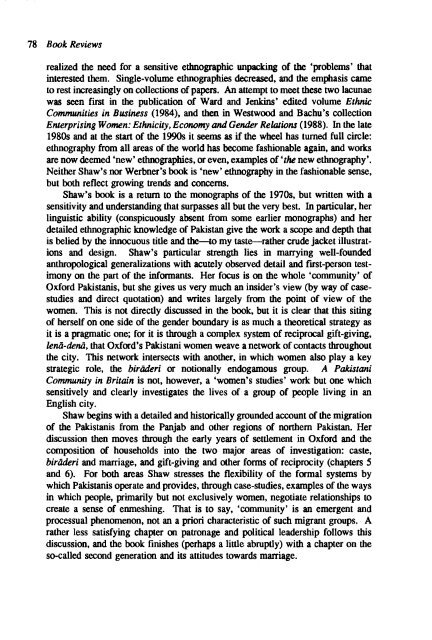1991 No. 1 CONTENTS - Institute of Social and Cultural ...
1991 No. 1 CONTENTS - Institute of Social and Cultural ...
1991 No. 1 CONTENTS - Institute of Social and Cultural ...
You also want an ePaper? Increase the reach of your titles
YUMPU automatically turns print PDFs into web optimized ePapers that Google loves.
78 Book Reviews<br />
realized the need for a sensitive ethnographic unpacking <strong>of</strong> the 'problems' that<br />
interested them. Single-volume ethnographies decreased, <strong>and</strong> the emphasis came<br />
to rest increasingly on collections <strong>of</strong> papers. An attempt to meet these two lacunae<br />
was seen first in the publication <strong>of</strong> Ward <strong>and</strong> Jenkins' edited volume Ethnic<br />
Communities in Business (1984), <strong>and</strong> then in Westwood <strong>and</strong> Bachu's collection<br />
Enterprising Women: Ethnicity, Economy <strong>and</strong> Gender Relalions (1988). In the late<br />
19808 <strong>and</strong> at the start <strong>of</strong> the 1990s it seems as if the wheel has turned full circle:<br />
ethnography from all areas <strong>of</strong> the world has become fashionable again, <strong>and</strong> works<br />
are now deemed 'new' ethnographies, or even, examples <strong>of</strong> ' the new ethnography'.<br />
Neither Shaw's nor Werbner's book is 'new' ethnography in the fashionable sense,<br />
but both reflect growing trends <strong>and</strong> concerns.<br />
Shaw's book is a return to the monographs <strong>of</strong> the 1970s, but written with a<br />
sensitivity <strong>and</strong> underst<strong>and</strong>ing that surpasses all but the very best. In particular, her<br />
linguistic ability (conspicuously absent from some earlier monographs) <strong>and</strong> her<br />
detailed ethnographic knowledge <strong>of</strong> Pakistan give the work a scope <strong>and</strong> depth that<br />
is belied by the innocuous title <strong>and</strong> the-to my taste-rather crude jacket illustrations<br />
<strong>and</strong> design. Shaw's particular strength lies in marrying well-founded<br />
anthropological generalizations with acutely observed detail <strong>and</strong> fmt-person testimonyon<br />
the part <strong>of</strong> the infonnants. Her focus is on the whole 'community' <strong>of</strong><br />
Oxford Pakistanis, but she gives us very much an insider's view (by way <strong>of</strong> casestudies<br />
<strong>and</strong> direct quotation) <strong>and</strong> writes largely from the point <strong>of</strong> view <strong>of</strong> the<br />
women. This is not directly discussed in the book, but it is clear that this siting<br />
<strong>of</strong> herself on one side <strong>of</strong> the gender boundary is as much a theoretical strategy as<br />
it is a pragmatic one; for it is through a complex system <strong>of</strong> reciprocal gift-giving,<br />
lenii-denii, that Oxford's Pakistani women weave a network <strong>of</strong> contacts throughout<br />
the city. This network intersects with another, in which women also play a key<br />
strategic role, the biriideri or notionally endogamous group. A Pakistani<br />
Community in Britain is not, however, a 'women's studies' work but one which<br />
sensitively <strong>and</strong> clearly investigates the lives <strong>of</strong> a group <strong>of</strong> people living in an<br />
English city.<br />
Shaw begins with a detailed <strong>and</strong> historically grounded account <strong>of</strong> the migration<br />
<strong>of</strong> the Pakistanis from the Panjab <strong>and</strong> other regions <strong>of</strong> northern Pakistan. Her<br />
discussion then moves through the early years <strong>of</strong> settlement in Oxford <strong>and</strong> the<br />
composition <strong>of</strong> households into the two major areas <strong>of</strong> investigation: caste,<br />
biriideri <strong>and</strong> marriage, <strong>and</strong> gift-giving <strong>and</strong> other fonns <strong>of</strong> reciprocity (chapters 5<br />
<strong>and</strong> 6). For both areas Shaw stresses the flexibility <strong>of</strong> the formal systems by<br />
which Pakistanis operate <strong>and</strong> provides, through case-studies, examples <strong>of</strong> the ways<br />
in which people, primarily but not exclusively women, negotiate relationships to<br />
create a sense <strong>of</strong> enmeshing. That is to say, 'community' is an emergent <strong>and</strong><br />
processual phenomenon, not an a priori characteristic <strong>of</strong> such migrant groups. A<br />
rather less satisfying chapter on patronage <strong>and</strong> political leadership follows this<br />
discussion, <strong>and</strong> the book finishes (perhaps a little abruptly) with a chapter on· the<br />
so-called second generation <strong>and</strong> its attitudes towards marriage.
















